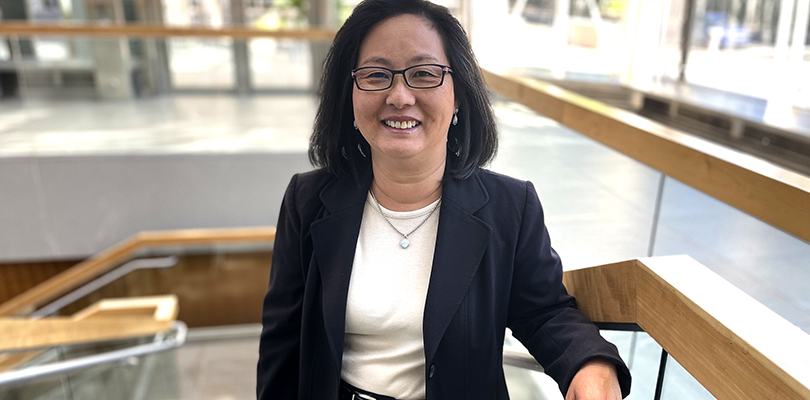CalPERS health experts are working to promote the use of biosimilars, a newer class of drugs that treats health conditions such as cancer, diabetes, Crohn’s disease, and more. The only problem? Not enough people, including those in the health field, know about them.
That’s where CalPERS’ leading biosimilar pharmaceutical expert in our Health Policy and Benefits Branch comes in. “When I learned about biosimilars, all I could think was ‘Why are we not offering these powerful new tools to our members?’” says Melissa Mantong, PharmD, MS, FCSHP.
Dr. Mantong has spent the last four years working with CalPERS health plans and pharmacy benefit managers to promote the use of biosimilars, highly similar versions of a class of drugs called biologics that offer a range of treatments that are made from living cells. And she wants you to know about them.
For example, if you suffer from rheumatoid arthritis, ulcerative colitis, or other autoimmune disorders, you now have more treatment options that are potentially less expensive.
What Are Biosimilars?
Biosimilars are highly similar versions of a group of drugs called biologics, which are among the fastest growing segments of the prescription drug market, according to the Food and Drug Administration (FDA).
Biologics are made from natural or living cells and tissues, and are typically used to treat complex, chronic conditions. Their uses have led to significant advances in the prevention, treatment, and outlook of many serious diseases such as cancer, rheumatoid arthritis, and multiple sclerosis.
Biosimilars are to complex biologic drugs as generics are to less complex brand-name drugs. Both are designed to have the same effect as their pricier counterparts.
Like Generics, But Not Really
Biosimilars are like generic drugs in that both are FDA approved, have highly similar efficacy and safety profiles to the original products (brand name drugs or biologics), and are considerably less expensive than their costlier brand-name drug counterparts. And both become available when drug companies’ exclusive patents on expensive brand drugs expire.
A difference between generic and biosimilar versions of a drug is that generic drugs have identical active ingredients to their brand name drugs, while biosimilars are highly similar to their original biologic drug but are not completely identical, due to the complexity of these biologic drugs.
Importantly, however, all biosimilars must have the same efficacy and safety results as their original biologic drug so that a patient would likely not notice a difference between the two. Because biologics come from living organisms, their structures are more complex, and their manufacturing process is more complicated and expensive. That’s where biosimilars come in.
The FDA makes sure biosimilars are as safe and effective as the original biologic product by:
- Approving biosimilars after a careful review of data, studies, and tests
- Monitoring safety and effectiveness after approval
- Checking for medication quality during production
- Reviewing patient safety reports made to the FDA
Once a biologic drug patent expires (usually after 20 years), biosimilars can create a similar product that has no clinically meaningful difference from a biologic that’s already FDA approved, and at a significantly lower cost.
What CalPERS Is Doing About It
Starting in 2021, the Health Policy and Benefits team worked with our Anthem PPO Basic Plan on Biosimilars First, a program that requires the use of biosimilars for new adult patients when a biosimilar was available and clinically appropriate. Anthem’s results from this initial study included widespread patient and provider acceptance. In 2022, the Biosimilar First program was expanded to include all drugs with available biosimilars and achieved a $3 million savings in prescription costs.
Today, CalPERS is exploring expansion of the Biosimilar First program to all our health plans and talking with our pharmacy benefit managers on a similar biosimilar program.
Substituting biosimilar drugs for biologics could drive down the price of expensive medicines, with savings estimated to be $38.4 billion or 5.9% of projected total U.S. spending on biologics from 2021 to 2025, according to the American Journal of Managed Care.
Why Haven’t I Heard of Biosimilars?
Unlike generics, biosimilars face a unique set of regulatory, manufacturing, and business challenges. Here’s why:
- The complex drug purchasing system in the U.S. actively engages in behind-the-scenes rebates and complex fee structures that prefers biologics.
- With traditional generics, pharmacists can substitute a generic without a new prescription. When it comes to biosimilars, pharmacists must request a new prescription, which creates another barrier to biosimilar use.
- Many doctors and patients are not familiar with biosimilars.
- Many doctors aren’t inclined to switch a patient to a biosimilar if they’re doing well on a biologic.
What You Can Do
If you have a complex medical condition, talk to your healthcare provider to see if your medication is available as a biosimilar and if it might be an option for you. Biosimilars compared to their original biologics:
- Are made with the same types of natural sources
- Provide the same treatment benefits
- Are administered the same way
- Have the same strength and dosage
- Have the same side effects
According to a 2021 study by the RAND Corporation, a non-profit global policy think tank, prices of prescription drugs in the U.S. are 2.4 times higher than the average price of prescriptions in comparable countries (Austria, Australia, Belgium, Canada, Germany, Japan, Sweden, Switzerland, and the United Kingdom).
“We believe biosimilars play a critical role in our ability to lower health care costs while offering the same efficacy and safety profile as the original biologic drugs,” Dr. Mantong says. “The results of adopting biosimilars is good for everyone.”

